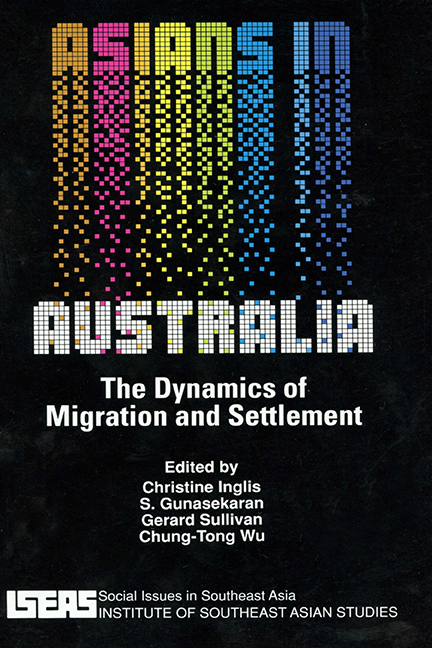Book contents
- Frontmatter
- Contents
- List of Tables
- List of Figures
- Introduction
- 1 China's Policy Towards Migrants, 1842–1949
- 2 Japanese Emigration Policy, 1880–1941
- 3 The “New” Migration and Australian Immigration Policy
- 4 Patterns of Settlement in Australia of Indochinese Refugees
- 5 Labour Market Outcomes Among the Chinese at the 1986 Census
- 6 Is There An Asian-Australian “Brain Drain”?
- 7 The “New” Migration of Asian Skills and Capital to Australia
4 - Patterns of Settlement in Australia of Indochinese Refugees
Published online by Cambridge University Press: 21 October 2015
- Frontmatter
- Contents
- List of Tables
- List of Figures
- Introduction
- 1 China's Policy Towards Migrants, 1842–1949
- 2 Japanese Emigration Policy, 1880–1941
- 3 The “New” Migration and Australian Immigration Policy
- 4 Patterns of Settlement in Australia of Indochinese Refugees
- 5 Labour Market Outcomes Among the Chinese at the 1986 Census
- 6 Is There An Asian-Australian “Brain Drain”?
- 7 The “New” Migration of Asian Skills and Capital to Australia
Summary
Since the beginning of 1975 approximately 180,000 Indochinese immigrants have settled in Australia. Although these Indochinese immigrants come from the same geographical region, they derive from a wide diversity of cultural, ethnic, linguistic and status groups.
Presently, there is not only a general misunderstanding about the number of Indochinese immigrants in Australia, but also a lack of awareness of the socio-economic characteristics of these communities. This chapter presents a preliminary analysis of some of the readily available socio-economic data from the 1986 Australian census of population and housing relating to the Cambodian, Lao and Vietnamese-born communities in Australia. In an attempt to place the data analysis for the Indochinese-born communities into perspective, comparable data on the “Other Asian”, “Other Overseas”, and Australian-born populations will also be presented. The “Other Asian” category includes the non-Indochinese countries of Southeast Asia, as well as the East, South and West (or Middle Eastern) Asian countries. There were 122,994 persons born in the Middle Eastern countries that were enumerated in the 1986 census, and these accounted for 28.4 per cent of the “Other Asian” category. The main Middle Eastern birthplace groups were Lebanon (56,341 persons), Turkey (24,529) and Cyprus (23,643), which accounted for 85.0 per cent of the total number of Middle Eastern-born persons enumerated in the 1986 census. The “Other Overseas” category refers to the non-Asian countries.
The principal aim of this chapter is to examine data on the labour force status, occupation, industry, and individual income of the three Indochinese-born communities. The data presented here have been extracted from the 1986 census microfiche tabulations, and show that the Indochinese-born communities exhibit a high labour force participation rate. Yet, among them there is a very high unemployment rate. At the same time, the majority of the Indochinese-born workers may be found in blue-collar occupations within the manufacturing industry sector. These attributes contribute to the low overall incomes of the Indochinese communities.
- Type
- Chapter
- Information
- Asians in AustraliaThe Dynamic of Migration and Settlement, pp. 73 - 116Publisher: ISEAS–Yusof Ishak InstitutePrint publication year: 1992



